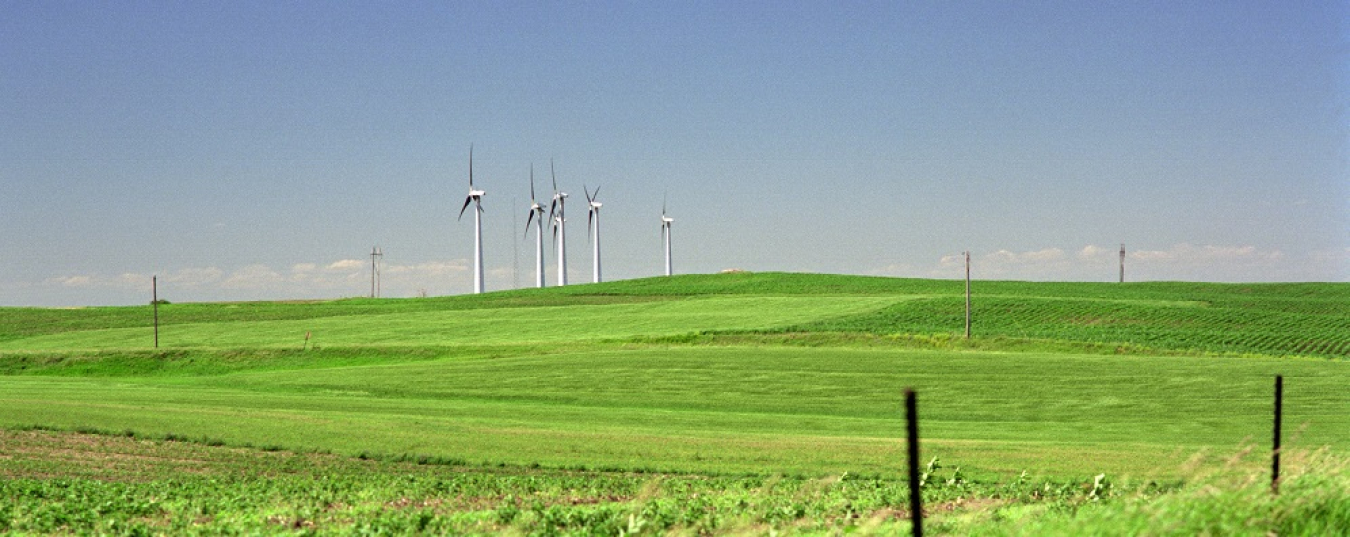MG2 Tribal Energy, a joint venture between the Mesa Grande Band of Mission Indians and commercial wind developer Geronimo Energy, is the first tribal entity to sign a power purchase agreement (PPA) with the federal government. The groundbreaking deal m...
Office of Indian Energy Policy and Programs
November 13, 2014
Photo by Warren Gretz, NREL 07317.
Last month, MG2 Tribal Energy won a competitive bid to supply the U.S. General Services Administration (GSA) with 140 megawatts (MW) of wind energy. The groundbreaking deal marks the largest wind energy purchase from a single source in federal contracting history. And it will supply GSA with all the clean, renewable energy it needs to meet the Obama Administration’s 20% by 2020 goal for federal agencies. The energy, which will come from the Walnut Ridge Wind Farm that MG2 is developing in northwest Illinois, will add more than 500,000 megawatt-hours (MWh) of electricity to the power grid annually.
MG2, a joint venture between the Mesa Grande Band of Mission Indians and commercial wind developer Geronimo Energy, is the first tribal entity to sign a power purchase agreement (PPA) with the federal government. Its groundbreaking success in landing the GSA contract can help pave the way for other Tribes, providing a constructive example of how to partner to build projects that can compete for PPAs with the federal government.
“This contract represents an important step forward in the history of the Mesa Grande Band because it is entirely consistent with our historic concern for Mother Earth and the continued availability of clean water, land, and air for future generations,” said Mesa Grande Band Chairman and MG2 President Mark Romero. “Few other economic development opportunities enable us to remain so true to our cultural and spiritual values."
As a non-gaming Tribe, Mesa Grande is also very committed to pursuing other revenue opportunities and creating a diverse economic portfolio that can create jobs and sustain the Tribe long-term, said another representative from the Tribe. So when Geronimo Energy first approached the Mesa Grande Band about partnering on wind energy, they were very interested. However, they had very little experience or knowledge about renewable energy technologies or market opportunities.
Likewise, Geronimo, which had already identified the wind site in Illinois and done much of the preliminary project development work, was very interested in partnering with Tribes to develop energy projects on tribal lands. But they lacked experience working in Indian Country and sought to gain working knowledge of the federal opportunities available to Tribes. So for both parties there was an opportunity for a win-win partnership that would allow them to learn from one another, potentially opening the door for future opportunities to develop energy projects on tribal lands, a goal they have in common.
As the Tribe and Geronimo worked to hammer out a framework for partnering on the project, they each turned to the U.S. Department of Energy (DOE) Office of Indian Energy for guidance. “The DOE Office of Indian Energy was very helpful in giving us a better understanding of what the opportunities were for Tribes and what the Indian Energy Act provided for in terms of tribal participation in the energy market,” said a tribal consultant who set up the initial meeting that led to MG2. She said the DOE Office of Indian Energy also provided insights that GSA leveraged in developing its request for proposals, which was originally directed specifically to Tribes and was later broadened to include small businesses while still encouraging Tribes to apply.
“They also helped educate GSA, which had never purchased energy from a tribal entity. DOE Office of Indian Energy Acting Director Pilar Thomas and her team worked directly with GSA to answer questions about the Indian Energy Act, including and how tribal preference might be implemented. Although ultimately tribal preference wasn’t a deciding factor in this deal, the education they provided to GSA really helped open the door for MG2.”
The Tribe, which took advantage of the tribal energy project development course material and other information available in the DOE Office of Indian Energy’s Resource Library before attending a forum on tribal clean energy project financing in San Diego in May 2014, also benefited directly from the DOE Office of Indian Energy’s expertise on tribal energy development.
“This project has really been a learning experience for our Tribe,” said Chairman Romero. “What we learned about how the federal government purchases energy—what the critical issues are, how a PPA gets negotiated, and what the economics of the deal are from the developer’s perspective—that has just been invaluable learning for us. We still have a lot to learn, but it really has been a great opportunity to learn about the marketplace and the basics of tribal energy development without having a lot of risk involved. From a learning standpoint this has been just tremendous. This has been like Energy Development 101 and we were right in the heart of it.”
For Geronimo Energy President Blake Nixon, securing a large federal contract is a significant milestone that portends a bright future for MG2. “Geronimo is proud to develop economically viable renewable energy projects for customers, now including the federal government, via this contract with the GSA. Our partnership in MG2 has been a mutually beneficial venture from the beginning, and by securing this PPA with the GSA, our partnership with the Mesa Grande has an exciting future.”

